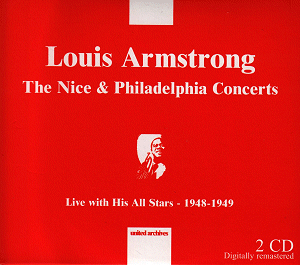CD1
1. My Monday Date
2. Royal Garden Blues
3. Black and Blue
4. Velma's Blues
5. Panama
6. That's My Desire
7. On the Sunny Side of the Street
8. When It's Sleepy Time Down South
9. Some Day
10. Boogie Woogie on Saint Louis Blues
11. Ain't Misbehavin'
12. I Cried for You
13. Steak Face
14. Basin Street Blues
15. When the Saints Go Marchin' In
16. Muskrat Ramble
17. Chinatown My Chinatown
CD2
1. Do You Know What It Means to Miss New Orleans?
2. Milenberg Joys
3. Body and Soul
4. Panama Rag
5. I'm Confessin'
6. Blue Skies
7. The One I Love
8. Little White Lies
9. Black and Blue
10. Baby, Won't You Please Come Home
11. Whispering/I Got a Right to Sing the Blues
12. Royal Garden Blues
13. Struttin’ with Some Barbecue
14. King Porter Stomp
Louis Armstrong – Trumpet, vocals
Barney Bigard – Clarinet (tracks I/1-13, 16;
II/1-14)
Jack Teagarden – Trombone, vocals (tracks I/1-13,
16, 17; II/1-14)
Earl Hines – Piano (tracks I/1-13, 16, 17; II/1-14)
Arvell Shaw – Bass (tracks I/1-13, 16; II/1-14)
Sidney Catlett – Drums (tracks I/1-13, 16)
Velma Middleton – Vocals (tracks I/4, 6, 12;
II/6, 8)
Wild Bill Davison – Cornet (tracks I/14, 15)
Albert Nicholas – Clarinet (tracks I/14, 15)
George Brunies – Trombone (tracks I/14, 15)
Art Hodes – Piano (tracks I/14, 15)
Danny Barker – Guitar (tracks I/14, 15)
Pops Foster – Bass (tracks I/14, 15)
Baby Dodds – Drums (tracks I/14, 15)
Pee Wee Russell – Clarinet (track I/17)
Jack Lesberg – Bass (track I/17)
J. C. Heard – Drums (track I/17)
Cozy Cole – Drums (tracks II/1-14)
This
double album is a strange concoction. It is
called the Nice and Philadelphia concerts
but four tracks were recorded elsewhere. And,
as the sleeve-note points out, the tape machine
used for the recordings at Nice only allowed
three minutes of recording, so there are sudden
endings to several tracks. In the first version
of Royal Garden Blues, the recording
suddenly cuts out in the middle of the bass
solo but resumes with the trumpet. A further
problem is that the sound quality is often
poor and fuzzy. In the middle of the first
CD, the sound is obscured by very audible
surface noise. It is like listening to the
music while someone is noisily sweeping the
floor.
Nevertheless,
it is good to have these recordings of Louis
Armstrong’s original All Stars, with Earl
Hines at the piano and Sid Catlett on drums.
The sleeve-notes quote some extraordinarily
vituperative comments about this band but
it was actually a fine ensemble which surrounded
Louis with genuine stars and allowed us to
enjoy his genius to the full – in a way that
the earlier recordings with his big band failed
to do. However often the All Stars played
these tunes, they still sound fresh and inventive.
Note, for instance, the glorious punctuations
that Armstrong and Teagarden supply behind
Velma Middleton’s vocals on Velma’s Blues.
And the flirtatious duet between Louis and
Velma on That’s My Desire is a classic.
Earl
Hines’s piano is not always clearly audible
but he is heard to advantage on Panama,
which also has a beautifully shaped solo by
Louis. Barney Bigard displays his complete
mastery of the clarinet on many tracks – particularly
in his feature on Body and Soul, ending
with a glorious cadenza which closes with
an immensely long-held note. And Jack Teagarden’s
trombone is mellow and melodic throughout.
These
recordings have plenty of faults but they
are important in marking the renaissance of
Louis Armstrong, at last allowed free rein
in a small group whose members matched him
perfectly.
Tony Augarde
